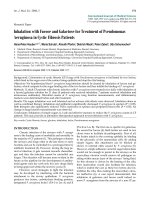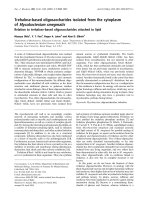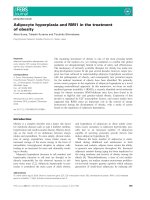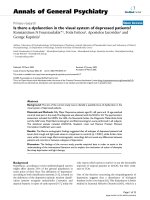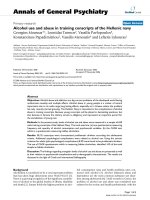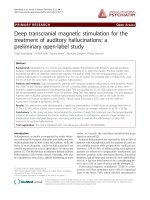Báo cáo y học: "Complications after spacer implantation in the treatment of hip joint infections"
Bạn đang xem bản rút gọn của tài liệu. Xem và tải ngay bản đầy đủ của tài liệu tại đây (192.92 KB, 9 trang )
Int. J. Med. Sci. 2009, 6
265
I
I
n
n
t
t
e
e
r
r
n
n
a
a
t
t
i
i
o
o
n
n
a
a
l
l
J
J
o
o
u
u
r
r
n
n
a
a
l
l
o
o
f
f
M
M
e
e
d
d
i
i
c
c
a
a
l
l
S
S
c
c
i
i
e
e
n
n
c
c
e
e
s
s
2009; 6(5):265-273
© Ivyspring International Publisher. All rights reserved
Research Paper
Complications after spacer implantation in the treatment of hip joint in-
fections
Jochen Jung
1
, Nora Verena Schmid
1
, Jens Kelm
1,2
, Eduard Schmitt
1
, Konstantinos Anagnostakos
1
1. Klinik für Orthopädie und Orthopädische Chirurgie, Universitätskliniken des Saarlandes, Homburg/Saar, Germany
2. Chirurgisch-Orthopädisches Zentrum Illingen/Saar, Germany
Correspondence to: Dr. Jochen Jung, Klinik für Orthopädie und Orthopädische Chirurgie, Universitätskliniken des Saar-
landes, D-66421, Homburg/Saar. Tel.: 0049-6841-1624575; Fax: 0049-6841-1624516; email:
Received: 2009.08.01; Accepted: 2009.09.01; Published: 2009.09.02
Abstract
The aim of this retrospective study was to identify and evaluate complications after hip
spacer implantation other than reinfection and/or infection persistence.
Between 1999 and 2008, 88 hip spacer implantations in 82 patients have been performed.
There were 43 male and 39 female patients at a mean age of 70 [43 – 89] years. The mean
spacer implantation time was 90 [14-1460] days. The mean follow-up was 54 [7-96] months.
The most common identified organisms were S. aureus and S. epidermidis. In most cases, the
spacers were impregnated with 1 g gentamicin and 4 g vancomycin / 80 g bone cement.
The overall complication rate was 58.5 % (48/82 cases). A spacer dislocation occurred in 15
cases (17 %). Spacer fractures could be noticed in 9 cases (10.2 %). Femoral fractures oc-
curred in 12 cases (13.6 %). After prosthesis reimplantation, 16 patients suffered from a
prosthesis dislocation (23 %). 2 patients (2.4 %) showed allergic reactions against the intra-
venous antibiotic therapy. An acute renal failure occurred in 5 cases (6 %). No cases of he-
patic failure or ototoxicity could be observed in our collective. General complications (con-
sisting mostly of draining sinus, pneumonia, cardiopulmonary decompensation, lower urinary
tract infections) occurred in 38 patients (46.3 %).
Despite the retrospective study design and the limited possibility of interpreting these find-
ings and their causes, this rate indicates that patients suffering from late hip joint infections
and being treated with a two-stage protocol are prone to having complications. Orthopaedic
surgeons should be aware of these complications and their treatment options and focus on
the early diagnosis for prevention of further complications. Between stages, an interdisci-
plinary cooperation with other facilities (internal medicine, microbiologists) should be aimed
for patients with several comorbidities for optimizing their general medical condition.
Key words: hip joint infection, hip spacers, spacer dislocation, prosthesis dislocation
Introduction
Antibiotic-loaded cement spacers have become a
popular procedure in the treatment of hip joint infec-
tions over the past two decades. Depending on the
definition of infection eradication and reinfection, hip
spacers have reportedly a success rate of > 90 % [1].
Although hip spacers are established as an ade-
quate treatment option in the management of these
infections, several complications might occur between
stages and, hence, endanger the functional outcome.
Besides a reinfection and/or infection persistence,
mechanical complications, such as spacer fracture,
spacer dislocation, and femoral fracture, or systemic
side effects (renal or hepatic failure, allergic reactions)
might lead to prolonged treatment courses between
Int. J. Med. Sci. 2009, 6
266
stages. These complications are certainly rare and the
exact incidence of the above mentioned complica-
tions, respectively, is still unknown. Moreover, it is
unclear whether a higher incidence of complications
between stages might be associated with a higher in-
cidence of mechanical complications after the pros-
thesis reimplantation at the site of a hip spacer im-
plantation.
Hence, the aim of the present retrospective study
was to register and define complications after hip
spacer implantation and prosthesis reimplantation,
respectively, in the treatment of late hip joint infec-
tions. Specific attention was paid to the aforemen-
tioned mechanical complications, systemic side effects
as well as general complications.
Patient – Methods
All patients’ records that have been treated by
hip spacer implantation in our institution between
01.01.1999 and 30.06.2008 have been retrospectively
evaluated regarding following parameters: primary
surgical indication, causative pathogen organism,
time between infection manifestation and spacer im-
plantation, duration of spacer implantation, spacer
articulation, impregnation of bone cement, systemic
antibiotics, and implant type at reimplantation.
Moreover, mechanical complications (spacer disloca-
tion, spacer fracture, femoral fracture, prosthesis dis-
location after reimplantation) and systemic side ef-
fects (renal and hepatic failure, respectively, allergic
reactions, ototoxicity) as well as general postoperative
complications were also documented. Only patients
with a sufficient documentation regarding all above
mentioned parameters were included in the study.
From the initially 101 identified patients, 19 pa-
tients were excluded due to insufficient documenta-
tion. From the remaining 82 patients, there were 43
male and 39 female patients at a mean age of 70 [43 –
89] years. According to the McPherson classification
[20], 15 patients were categorized as IIIA1, 4 as IIIA2,
1 as IIIA3, 25 as IIIB1, 9 as IIIB2, 17 as IIIC1, 10 as
IIIC2, and 1 as IIIC3.
The most common primary surgery was a pri-
mary total hip arthroplasty followed by bacterial
coxitis. Data about primary surgical procedures is
summarized in Table 1.
There were 60 mono-, 12 bi-, and 3 polymicrobial
infections. In 7 cases no causative pathogen organism
could be identified, however, the histopathological
findings revealed in all cases signs of osteomyelitis,
respectively. The most common identified organism
was Staphylococcus aureus followed by Staphylo-
coccus epidermidis (Table 2).
Table 1: Primary surgical indications and antibiotic im-
pregnation of the bone cement at the site of spacer im-
plantation in the treatment of hip joint infections.
Primary surgery n= Antibiotic impregnation of hip
spacer (/80 g bone cement)
n=
primary THA 45 1 g Gentamicin + 4 g Vancomy-
cin
77
bacterial coxitis 15 1 g Gentamicin + 0.8 g Tei-
coplanin
8
aseptic cup loosening 8 1 g Gentamicin + 4 g Cefotaxim 2
osteosynthesis for femo-
ral neck fracture
5 1 g Gentamicin + 2 g Clinda-
mycin
1
aseptic stem loosening 3
dual head prosthesis 3
osteosynthesis for inter-
trochanteric fracture
1
septic femoral head ne-
crosis
1
resection of heterotopic
ossifications
1
THA: total hip arthroplasty
Table 2: Pathogen organisms in late hip joint infections.
Organism n=
S. aureus 25
S. epidermidis 25
E. faecalis 8
MRSA 8
E. coli 6
ß-hem. Streptococci 5
Ps. aeruginosa 3
C. albicans 3
a-hem. Streptococci 2
K. pneumoniae 2
S. capitis 1
S. haemolyticus 1
S. hominis 1
S. agalactiae 1
E. faecium 1
P. mirabilis 1
Str. auginosus 1
Bacillus sp. 1
Streptococci sp. 1
Peptostreptococci sp. 1
gram+ cocci 1
( no further specification)
MRSA: methicillin-resistant S. aureus
Antibiotics were administered in all cases after
consultation with our Microbiologic Institute. The
most common combination used was vancomycin
and rifampicin followed by clindamycin and fluclox-
acillin (data not shown in a table). If no bacterium
could be isolated, a broad spectrum antibiosis (flu-
cloxacillin and clindamycin) was prescribed. If the
general medical condition allowed for it and no anti-
biotic-related complications occured, antibiotics were
given intravenous for the first 4 weeks followed by
oral antibiotics for another two weeks.
In these 82 patients, 88 spacer implantations
have been performed (in 5 patients spacer exchange,
Int. J. Med. Sci. 2009, 6
267
in one case bilaterally). The time between infection
manifestation and spacer implantation was meanly 6
[1-108] weeks. All infections were late infections ex-
cept for the cases suffering from a bacterial coxitis.
The mean spacer implantation time was 90 [14-1460]
days. The mean follow-up of these 82 patients was 54
[7-96] months.
All patients have been treated by the same
one-size custom-made spacer. The spacer has been
intraoperatively produced by means of a two-parted
mould. The mould consists of polyoxymethylene
(POM). In all cases Refobacin – Palacos (0.5 g gen-
tamicin/ 40 g cement) has been used due to its supe-
rior elution characteristics compared with other bone
cements [1]. For the spacer production 80 g of poly-
methylmethacrylate (PMMA) are required. Depend-
ing on the causative pathogen organism and its sensi-
tivity profile the bone cement was optionally loaded
with a second antibiotic. In cases of a preoperative
unidentified bacterium or if the infection was re-
vealed during the operation for presumed aseptic
conditions, the combination of 1 g gentamicin/ 4 g
vancomycin/ 80 g PMMA was routinely used. Each
spacer has a head diameter of 50 mm, a stem length of
10 cm, and a total surface area of 13300 mm² [3].
In case of acetabular defects a special mould is
also available. The acetabular component has an in-
side/outside diameter of 53/ 56 mm and a total sur-
face area of 4410 mm² [3].
From the 88 spacers implanted, 82 acted as a
hemiarthroplasty, whereas only in 6 cases a spacer
cup has been implanted. In 70 cases a “normal” spacer
has been implanted, whereas in the remaining 18
cases a spacer head has been placed onto the in situ
remained femoral stem. In the latter cases, there was
either an isolated septic cup loosening at no stem in-
fection as primary indication, or due to the type of
implant primarily used or due to the femoral bone
quality (associated with a higher risk of femoral frac-
ture) we decided not to remove the femoral stem.
For loading of the bone cement, the combination
of gentamicin and vancomycin was most frequently
used followed by the combination of gentamicin and
teicoplanin. Data about the antibiotic impregnation of
hip spacers is summarized in Table 1.
After six weeks of antibiotic treatment, the anti-
biotics were paused and the serum C-reactive protein
(CRP) checked. If its level had returned to normal,
two weeks later another CRP-control was performed.
If also normal, the second stage was planned if the
wound had healed and the general medical condition
of the patient allowed for it.
A total prosthesis reimplantation was performed
in 63 cases. In 24 cases cementless components have
been reimplanted, in 20 cases hybrid, in 10 cemented,
and in 9 patients reverse hybrid. In one case, the pros-
thesis reimplantation was performed elsewhere. In 12
cases, only a cup reimplantation was performed
(“spacer head” group). 5 patients passed away be-
tween stages, whereas in 7 cases the spacer remained
in situ because either the patient was not willing to
undergo further surgery or because the comorbidities
of the patient did not allow the prosthesis reimplan-
tation.
Results
Mechanical complications
A spacer dislocation occurred in 15 cases (17 %).
From these 15 cases, 12 patients have been treated
conservatively by reduction and immobilization in a
hip orthesis (Newport orthesis, Fa. Ormed, Freiburg,
Germany) during the remaining time between stages.
The other three cases underwent further surgical
procedures; in one case (combined spacer dislocation
and -fracture), the spacer had been exchanged,
whereas the other two cases had been treated by re-
section arthroplasty after recurrent spacer disloca-
tions and unsuccessful conservative treatment.
Spacer fractures could be noticed in 9 cases (10.2
%). 7 of them were localized in the distal part of the
spacer stem and were asymptomatic. The other two
cases were spacer-neck fractures and had been treated
by subsequent spacer exchange.
In one case a spacer protrusion was evident over
time and the patient was advised to put no weight
bearing on the leg.
Femoral fractures occurred in 12 cases (13.6 %). 5
out of these 12 cases occurred at the first stage and
were treated by implantation of an antibiotic-coated
femoral nail and spacer implantation on top. Four
cases with a femoral scissure, respectively, were man-
aged by minimal weight-bearing of the particular ex-
tremity. One case suffering from an avulsion of the
minor trochanter was treated by cerclage refixation.
After prosthesis reimplantation, one patient suffered
from a periprosthetic fracture which was treated with
a plate osteosynthesis. One patient had a fracture be-
neath the spacer stem and was treated by implanta-
tion of an antibiotic-coated prosthesis stem and
placement of a spacer head onto the stem.
After prosthesis reimplantation, 16 patients suf-
fered from a prosthesis dislocation (23 %). 12 cases
could be successfully managed by reduction and
immobilization in a hip orthesis for the following 12
weeks. The other 4 cases had recurrent dislocations
and were managed by acetabular socket explantation
and implantation of a constrained cup (Fa. Waldemar
Int. J. Med. Sci. 2009, 6
268
Link, Hamburg, Germany), respectively.
Systemic side effects
2 patients (2.4 %) showed allergic reactions (rash
and pruritus) against the intravenous antibiotics ad-
ministered (in both cases combination of clindamycin
and flucloxacillin). The symptoms were resolved after
adjustment of the antibiotic therapy.
An acute renal failure occurred in 5 cases (6 %). 2
patients could be successfully treated conservatively,
whereas 2 patients had to be treated by renal dialysis.
One patient suffering from multiple myeloma passed
away after renal failure and cardiopulmonary de-
compensation. Unfortunately, the retrospective
evaluation of the patients’ records did not allow any
differentiation of the particular cause of the renal
failure, respectively (antibiotic-impregnation of the
spacer, systemic antibiotics, other medication).
No cases of hepatic failure or ototoxicity could be
observed in our collective.
General complications
General complications (other than the aforemen-
tioned ones) occurred in 38 patients (46.3 %).
4 patients had a draining sinus after the first
stage and 6 after the second stage, respectively. Of
these 10 cases, 2 resolved after local treatment,
whereas the other 8 have been treated by revision,
haematoma removal and pulsatile lavage. None of
these patients had a reinfection or infection persis-
tence during follow-up.
6 patients suffered from a pneumonia which
could be treated successfully with antibiotics in all
cases.
In 5 cases after spacer implantation and in 2
cases after prosthesis reimplantation a cardiopul-
monary decompensation emerged which could be
successfully managed by adjustment of the cardiac
medication and fluid restriction, respectively.
One patient denied a prosthesis reimplantation.
In this case, the patient started to increase
weight-bearing on the leg 3 months after spacer im-
plantation. 13 months later, X-rays revealed an as-
ymptomatic acetabular fracture without any spacer
dislocation. At a follow-up of 52 months the patient is
still free of any infection signs and has no complaints
at an almost free range of motion.
4 patients developed postoperatively a transitory
psychotic syndrome which regressed over the first 2
weeks, respectively.
3 patients had an antibiotic-associated colitis by
Clostridum difficile and have been orally treated with
vancomycin. Also 3 patients had a central venous
catheter – associated sepsis. A thrombosis, epileptic
seizures, and lower urinary tract infections could be
noticed in 2 cases, respectively. A pleura empyema, a
heparin-induced thrombocytopenia (HIT), a case of
pelviperitonitis with bladder necrosis and subsequent
surgical intervention, a cholecystitis with subsequent
cholecystectomy, a myocardial infarction, and an in-
farction of the A. cerebri media could be observed in
one case, respectively.
2 patients passed away after the first stage and 2
after the second stage due to cardiopulmonary de-
compensation, respectively. As already mentioned,
one patient suffering from multiple myeloma passed
away after renal failure and cardiopulmonary de-
compensation.
The overall complication rate was 58.5 % (48/82
cases).
Discussion
A reinfection and/or infection persistence are
the most feared complications after hip spacer im-
plantation because they can be both associated with
subsequent surgical revisions and higher morbidity
and mortality rates, respectively. However, several
other complications might also occur during a
two-stage treatment protocol for late hip joint infec-
tions which can also lead to prolonged treatment
courses and endanger the functional outcome. Al-
though these complications are frequently not men-
tioned or insufficiently documented in the literature,
they are surely of no minor value compared with an
infection persistence or reinfections.
Mechanical complications
Mechanical complications belong certainly to the
most important complications after hip spacer im-
plantation because they are often associated with
subsequent surgical interventions and may impair the
functional outcome.
The exact incidence of mechanical complications
is unknown. Hereby, several parameters might play a
role: the spacer’s production (hand-made vs. stan-
dardized), the spacer’s geometry, the head/neck ratio,
acetabular and/or femoral defects, mismatch of
spacer’s head size to the acetabulum size, the art of
femoral fixation, muscular insufficiency, prior surgi-
cal revisions, poor bone quality, and incompliance of
the patient with regard to partial weight bearing.
A review of the literature about hip spacers
showed a tendency that hand-made spacers might
dislocate more often than standardized-made ones
[1]. However, a significant difference could not be
assessed due to inhomogenities of the patients’ col-
lectives and insufficient documentation regarding the
spacer production and fixation, respectively.
Leunig et al. [18] were one of the first who tried
Int. J. Med. Sci. 2009, 6
269
to interpret and explain these findings. The authors
have recognized that the geometrical form of the
spacer plays an important role. In spacers which were
free of complications, the neck to head-ratio was sig-
nificantly lower (0.76±0.05) than in those with dislo-
cations (0.96±0.19). A second factor associated with
failure was an insufficient deep anchorage in the in-
tramedullary canal, being 22±33 mm in the failure
group, while complication-free spacers were on av-
erage attached to a depth of 57±41 mm.
Regarding the femoral fixation of hip spacers,
there exist to our knowledge 3 methods: i) press-fit, ii)
partially or totally cementation, and iii) the “glove“ –
technique [3]. The latter technique has been recently
described and provides a stable fixation onto the
proximal femur at facilitating the spacer’s explanta-
tion since the spacer can be removed at one piece and
there is no need for removal of any cement debris
compared with other normal cementation techniques.
However, it is unclear, which of the above mentioned
techniques is the most superior one in the prevention
of spacers’ dislocations regarding the femoral part.
In the literature, the dislocation rates after hip
spacer implantation may strongly vary depending on
the art of the spacer’s production as well as the fixa-
tion method. Leunig et al. [18] reported dislocations of
the hip in 5 of 12 patients after use of hand-formed
spacers, whereas Magnan et al. [19] and Duncan et al.
[9] could notice a rate of 1/10 and 3/13 dislocations
after implantation of a standardized hip spacer, re-
spectively. On the other hand, Ries and Jergesen [26],
Koo et al. [16], Shin et al. [30] and Takahira et al. [33]
could not observe any dislocation during implanta-
tion of standardized spacers, respectively.
In our collective we could notice a spacer dislo-
cation rate of 17 %. This rate might appear high,
however, this is the rate of a 10-year collective. Over
the years we have gained experience with this treat-
ment option, and advances in the surgical technique,
instruments and fixation method have led to a re-
duced rate over the last years. We have also made the
experience that careful education of the patients by
our physiotherapists with regard to walking attitude,
partial weight bearing and joint motion is very im-
portant in the prevention of dislocations. Certainly, a
disadvantage of our treatment protocol is the one-size
spacer which has been implanted in all cases. Perhaps,
if we have had several moulds for spacer production
and each case would have been treated by a more
“anatomical” spacer, the dislocation rate might have
been lower.
The rate of spacer fractures in our series was
approximately 10 %. Interestingly, the majority of the
cases had no symptoms at all and only in 2 cases the
spacer had to be exchanged in an additional surgery.
For prevention of a spacer fracture, the surgeon may
consider inserting a metallic endoskeleton into the
spacer; however, literature data are scarce about this
topic. Schöllner et al. investigated in vitro the me-
chanical properties of gentamicin-loaded hip spacers
after insertion of Kirschner wires [31]. Stress experi-
ments showed an average failure load of 1.6 kN. The
insertion of the K-wires prevented any dislocation of
the spacer fragments, but did not significantly im-
prove the mechanical properties. Kummer et al.
compared in vitro the mechanical properties of com-
mercially available hip spacers containing a substan-
tial stainless steel central core with experimental
spacers containing Steinmann pins, intramedullary
nails with two lag screws and Charnley prostheses,
respectively [17]. The authors reported that all con-
structs based upon the Charnley prostheses and the
commercial spacers did not fail at 3000 N; the other
two constructs failed at significant lower loads (pins
at 832 N and nails at 1275 N, respectively). Thielen et
al. investigated in vitro the mechanical stability of
reinforced hip spacers (either a rod pin with a 5 mm
diameter or a “full-stem” endoskeleton; both consist-
ing of titanium grade two) compared with
non-reinforced spacers [34]. At cycling testing, non-
reinforced spacers failed at 400-600 N, whereas
rod-reinforced spacers failed at 1000-1300 N.
“Full-stem” reinforced spacers failed at 2380-4311 N,
depending on the thickness of endoskeleton used
(6/8/10 mm). To our knowledge, there are no clinical
data available that have demonstrated that the inser-
tion of a metallic endoskeleton significantly improves
the mechanical properties of hip spacers or reduces
the rate of mechanical complications.
Moreover, it is still unclear whether the insertion
of a metallic endoskeleton has a negative influence on
the pharmacokinetic properties of the spacer. Ex-
perimental data have shown that the release of com-
mercially-impregnated antibiotics from hip spacers is
significantly increased in the presence of an endo-
skeleton, whereas the elution of additional, incorpo-
rated antibiotics is decreased [2]. Until this question is
answered, we recommend that metallic endoskeletons
should not be routinely inserted into hip spacers in
clinical practise, but only in exceptional cases for pa-
tients with a higher fracture risk (poor patient com-
pliance, high Body-Mass-Index, poor bone quality or
osteoporosis).
Femoral fractures occurred in 12 cases (13.6 %) in
our series. Hereby, a differentiation should be made
between those at the first stage, between stages, and
after prosthesis reimplantation, respectively. More-
over, not every fracture has to be surgically treated, as


